Abstract
1--Responses (relaxation) to the beta-adrenoceptor agonists, isoprenaline, fenoterol or noradrenaline, were obtained on cat tracheal preparations contracted with a submaximal concentration of carbachol (0.5 microM). 2--The relative potencies of isoprenaline: fenoterol: noradrenaline were 100:8.1:10.7. From this, it was concluded that responses were mediated predominantly by beta 1-adrenoceptors but that a minor population of beta 2-adrenoceptors might also be involved. 3--Schild plots for the selective antagonists atenolol (beta 1-selective) or ICI 118,551 (beta 2-selective) were in different locations, i.e. were separated, depending on whether the antagonist was antagonizing noradrenaline or fenoterol. This supported the conclusion that beta 2- as well as beta 1-adrenoceptors were involved in mediating the response. In this respect, cat trachea resembles cat atria (rate responses). 4--In the presence of atenolol the concentration-response curves to fenoterol became biphasic. This was interpreted as indicating that the beta 2-adrenoceptors were too few in number to elicit a maximum tissue response. 5--Responses to isoprenaline of cat trachea were potentiated by the extraneuronal uptake inhibitor drugs, corticosterone and metanephrine. This indicated that extraneuronal uptake could modulate beta-adrenoceptor-mediated responses (relaxation) of cat trachea. 6--Cat trachea resembles guinea-pig trachea in that (i) the beta-adrenoceptor population mediating relaxation is mixed (beta 1 + beta 2) and (ii) responses to isoprenaline are modulated by its extraneuronal uptake. However, cat trachea differs from guinea-pig trachea in that the predominant beta-adrenoceptor sub-type is beta 1 not beta 2.
Full text
PDF
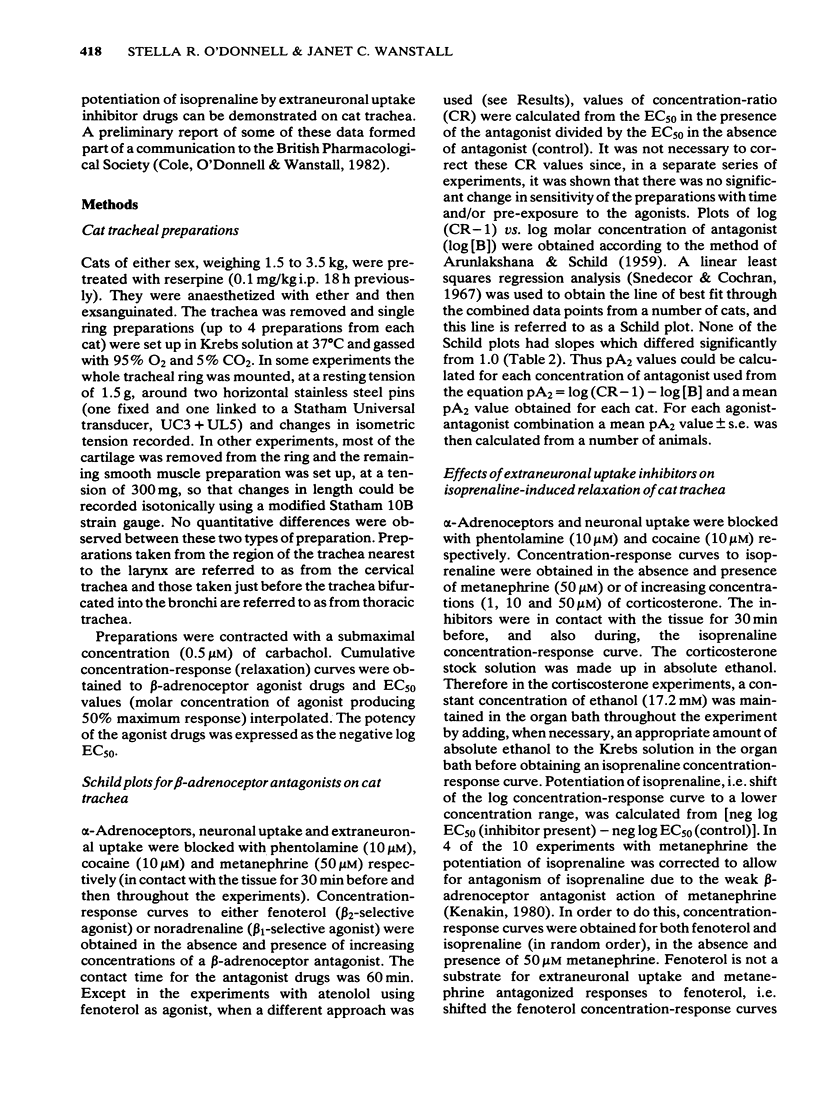

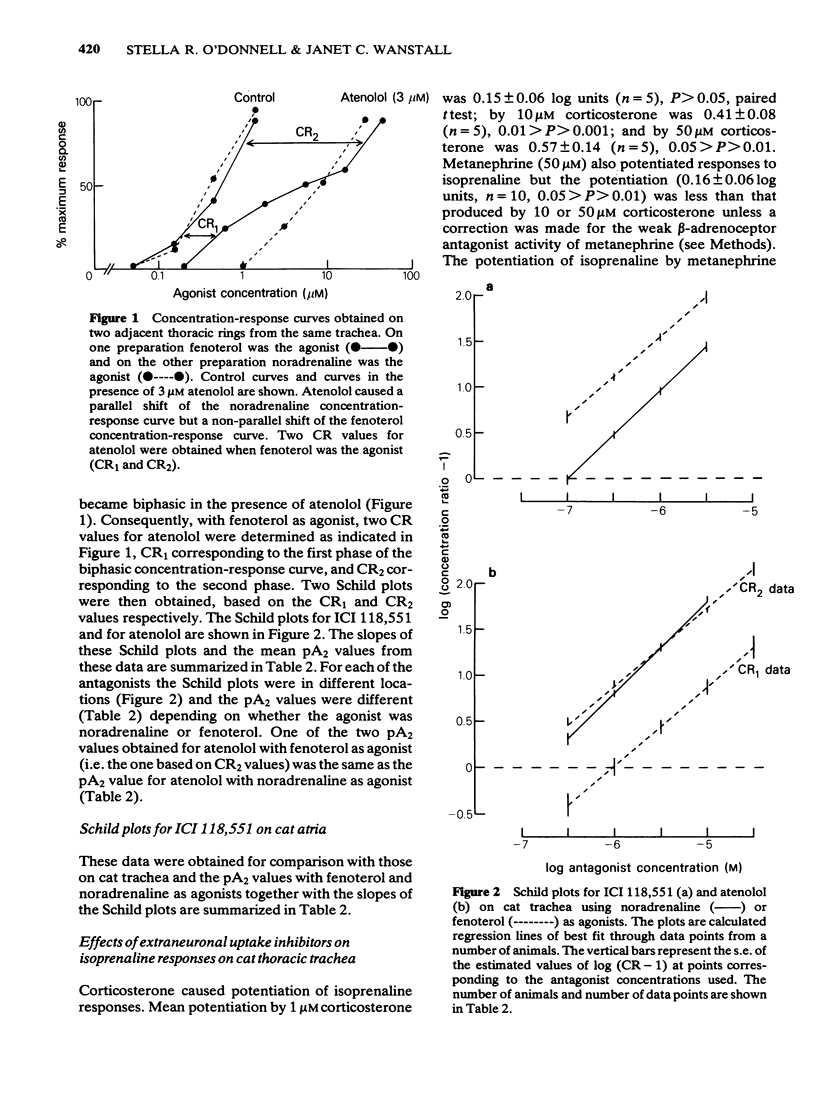
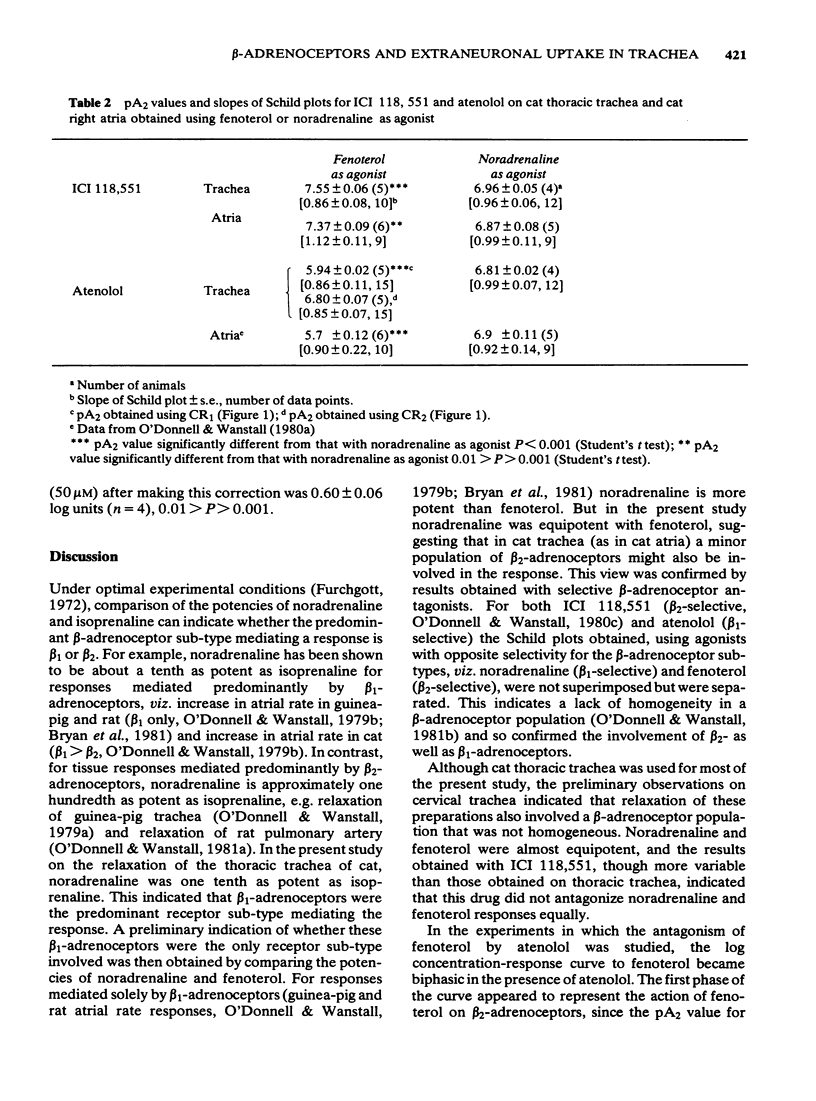
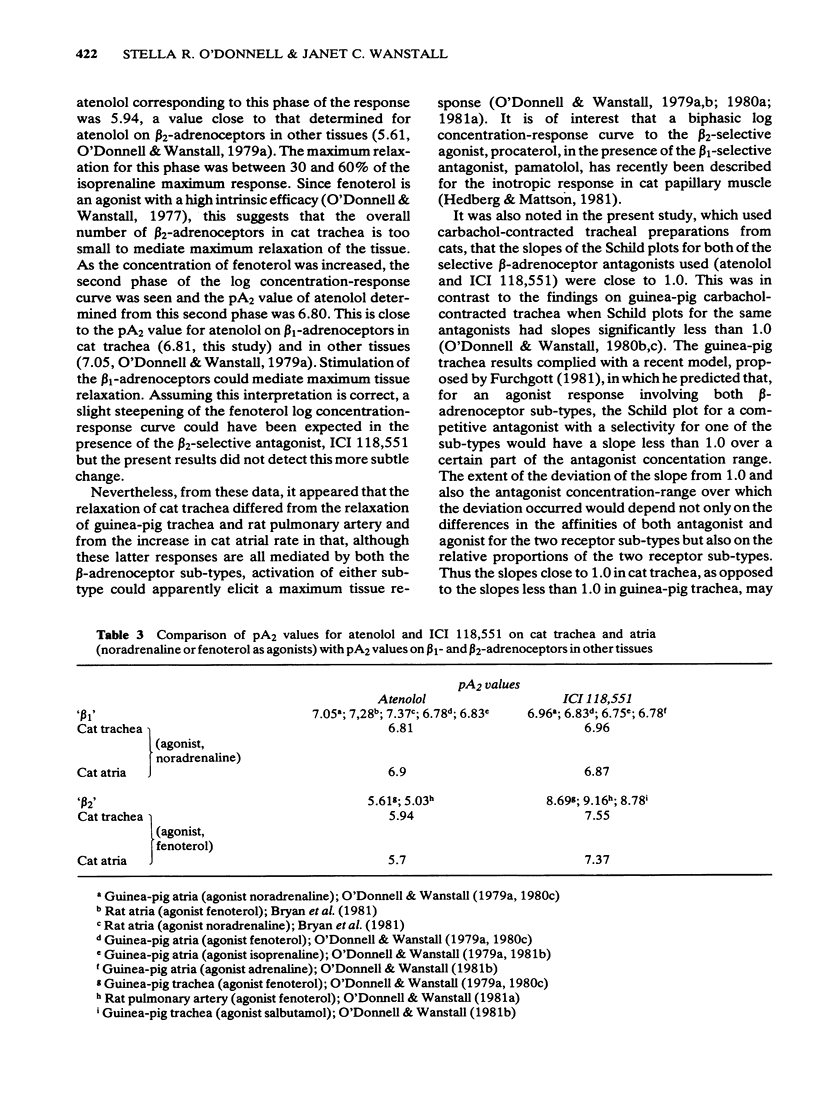
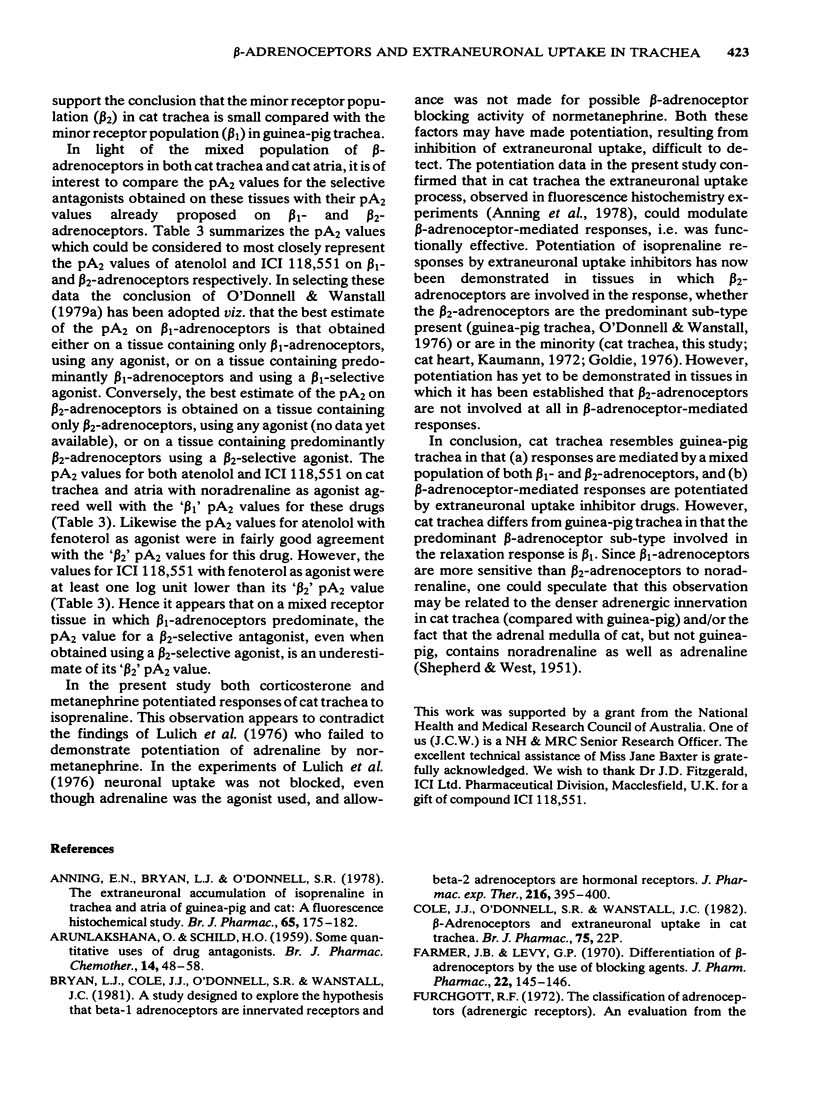
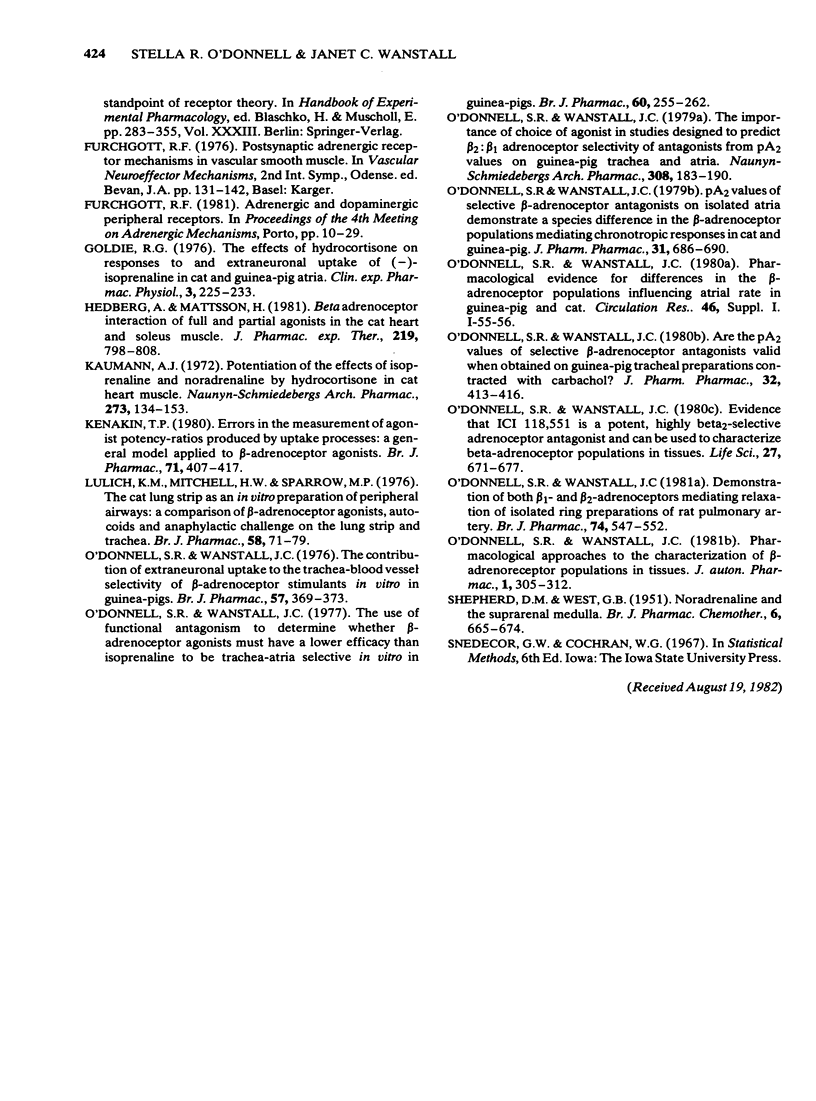
Selected References
These references are in PubMed. This may not be the complete list of references from this article.
- ARUNLAKSHANA O., SCHILD H. O. Some quantitative uses of drug antagonists. Br J Pharmacol Chemother. 1959 Mar;14(1):48–58. doi: 10.1111/j.1476-5381.1959.tb00928.x. [DOI] [PMC free article] [PubMed] [Google Scholar]
- Anning E. N., Bryan L. J., O'Donnell S. R. The extraneuronal accumulation of isoprenaline in trachea and atria of guinea-pig and cat: a fluorescence histochemical study. Br J Pharmacol. 1979 Feb;65(2):175–182. doi: 10.1111/j.1476-5381.1979.tb07816.x. [DOI] [PMC free article] [PubMed] [Google Scholar]
- Bryan L. J., Cole J. J., O'Donnell S. R., Wanstall J. C. A study designed to explore the hypothesis that beta-1 adrenoceptors are "innervated" receptors and beta-2 adrenoceptors are "hormonal" receptors. J Pharmacol Exp Ther. 1981 Feb;216(2):395–400. [PubMed] [Google Scholar]
- Farmer J. B., Levy G. P. Differentiation of beta-adrenoreceptors by the use of blocking agents. J Pharm Pharmacol. 1970 Feb;22(2):145–146. doi: 10.1111/j.2042-7158.1970.tb08414.x. [DOI] [PubMed] [Google Scholar]
- Goldie R. G. The effects of hydrocortisone on responses to and extraneuronal uptake of (-)-isoprenaline in cat and guinea-pig atria. Clin Exp Pharmacol Physiol. 1976 May-Jun;3(3):225–233. doi: 10.1111/j.1440-1681.1976.tb02668.x. [DOI] [PubMed] [Google Scholar]
- Hedberg A., Mattsson H. Beta adrenoceptor interaction of full and partial agonists in the cat heart and soleus muscle. J Pharmacol Exp Ther. 1981 Dec;219(3):798–808. [PubMed] [Google Scholar]
- Kaumann A. J. Potentiation of the effects of isoprenaline and noradrenaline by hydrocortisone in cat heart muscle. Naunyn Schmiedebergs Arch Pharmacol. 1972;273(1):134–153. doi: 10.1007/BF00508086. [DOI] [PubMed] [Google Scholar]
- Kenakin T. P. Errors in the measurement of agonist potency-ratios produced by uptake processes: a general model applied to beta-adrenoceptor agonists. Br J Pharmacol. 1980;71(2):407–417. doi: 10.1111/j.1476-5381.1980.tb10953.x. [DOI] [PMC free article] [PubMed] [Google Scholar]
- Lulich K. M., Mitchell H. W., Sparrow M. P. The cat lung strip as an in vitro preparation of peripheral airways: a comparison of beta-adrenoceptor agonists, autacoids and anaphylactic challenge on the lung strip and trachea. Br J Pharmacol. 1976 Sep;58(1):71–79. doi: 10.1111/j.1476-5381.1976.tb07694.x. [DOI] [PMC free article] [PubMed] [Google Scholar]
- O'Donnell S. R., Wanstall J. C. Are the pA2 values of selective beta-adrenoceptor antagonists valid when obtained on guinea-pig tracheal preparations contracted with carbachol? J Pharm Pharmacol. 1980 Jun;32(6):413–416. doi: 10.1111/j.2042-7158.1980.tb12954.x. [DOI] [PubMed] [Google Scholar]
- O'Donnell S. R., Wanstall J. C. Demonstration of both beta 1- and beta 2-adrenoceptors mediating relaxation of isolated ring preparations of rat pulmonary artery. Br J Pharmacol. 1981 Nov;74(3):547–552. doi: 10.1111/j.1476-5381.1981.tb10463.x. [DOI] [PMC free article] [PubMed] [Google Scholar]
- O'Donnell S. R., Wanstall J. C. Evidence that ICI 118, 551 is a potent, highly Beta 2-selective adrenoceptor antagonist and can be used to characterize Beta-adrenoceptor populations in tissues. Life Sci. 1980 Aug 25;27(8):671–677. doi: 10.1016/0024-3205(80)90008-9. [DOI] [PubMed] [Google Scholar]
- O'Donnell S. R., Wanstall J. C. Pharmacological approaches to the characterization of beta-adrenoreceptor populations in tissues. J Auton Pharmacol. 1981 Sep;1(4):305–312. doi: 10.1111/j.1474-8673.1981.tb00460.x. [DOI] [PubMed] [Google Scholar]
- O'Donnell S. R., Wanstall J. C. The contribution of extraneuronal uptake to the trachea-blood vessel selectivity of beta-adrenoceptor stimulants in vitro in guinea-pigs. Br J Pharmacol. 1976 Jul;57(3):369–373. doi: 10.1111/j.1476-5381.1976.tb07675.x. [DOI] [PMC free article] [PubMed] [Google Scholar]
- O'Donnell S. R., Wanstall J. C. The importance of choice of agonist in studies designed to predict beta 2 : beta 1 adrenoceptor selectivity of antagonists from pA2 values on guinea-pig trachea and atria. Naunyn Schmiedebergs Arch Pharmacol. 1979 Sep;308(3):183–190. doi: 10.1007/BF00501381. [DOI] [PubMed] [Google Scholar]
- O'Donnell S. R., Wanstall J. C. The use of functional antagonism to determine whether beta-adrenoceptor agonists must have a lower efficacy than isoprenaline to be trachea-atria selective in vitro in guinea-pigs. Br J Pharmacol. 1977 Jun;60(2):255–262. doi: 10.1111/j.1476-5381.1977.tb07748.x. [DOI] [PMC free article] [PubMed] [Google Scholar]
- O'Donnell S. R., Wanstall J. C. pA2 values of selective beta-adrenoceptor antagonists on isolated atria demonstrate a species difference in the beta-adrenoceptor populations mediating chronotropic responses in cat and guinea-pig. J Pharm Pharmacol. 1979 Oct;31(10):686–690. doi: 10.1111/j.2042-7158.1979.tb13629.x. [DOI] [PubMed] [Google Scholar]
- SHEPHERD D. M., WEST G. B. Noradrenaline and the suprarenal medulla. Br J Pharmacol Chemother. 1951 Dec;6(4):665–674. doi: 10.1111/j.1476-5381.1951.tb00678.x. [DOI] [PMC free article] [PubMed] [Google Scholar]


